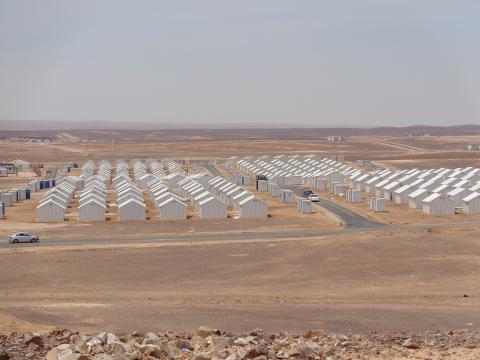Azraq – another stop on the journey home

From a distance, it looks like a white smudge on the horizon.
Azraq Refugee Camp came first came into my view four or five kilometres from its main entrance. Off in the distance, against the harsh brown scrub of the Jordanian desert, I saw hundreds upon hundreds of small, white shelters lined up in straight rows, waiting to provide protection from the hot sun and the elements for thousands of refugees who have fled the conflict in Syria.
More than three years after the fighting that has torn Syria apart began, aid agencies and representatives of the Government of Jordan are putting the finishing touches on the Azraq Refugee camp, located about 100 km east of the capital, Amman. The camp will begin accepting its first refugees at the end of April and, when it is fully completed, it will have the capacity to house up to 100,000 people.
World Vision has been one of the key players in the development of the new camp, and the agency is justifiably proud of its work. To provide clean drinking water to up to 30,000 people, World Vision and its partners have laid 12.6 km of pipelines and installed 39 tap stands where residents can come to collect water for cooking, washing and sanitation needs. More than 2,000 latrines and shower spaces have also been built, which means fewer families will have to share the same facilities. Privacy means a lot to the refugees, many of whom have undergone incredible hardships which forced them to leave Syria and welcome any semblance of a normal life.
Azraq is being seen by many as a model for what a refugee camp should look like in the future. There are schools, a supermarket and a hospital as well as community centres and recreational facilities, like playgrounds for children and soccer fields for adolescents. But, walking the silent, dusty streets between the now-empty metal shelters, two thoughts dominated my mind:
First, the recognition that while refugee camps can be made as pleasant as possible, they cannot and must never be considered “home”. And, make no mistake, as difficult as the situation is in Syria right now and will likely be for years to come, most of the Syrian refugees that World Vision has worked with over the past three years say their first desire is to go home as soon as conditions permit.
And, second, my mind also filled with images of the Syrian refugee children I met on my last visit to Jordan and Lebanon in June of 2013. Soon, thousands of other children just like them would fill this camp: playing on the soccer pitches and basketball courts, learning in the classrooms and helping their parents cope with the stresses of life far from their Syrian homes. I kept wondering what kind of dreams a child could have in place like Azraq, where there was nothing around them but desert, a few stunted bushes and the oppressive sun.
A word that I have heard so often since arriving in Jordan last week is “Insha’Allah” – the Arabic phrase that translates as “god willing.” People throughout the Middle East use this phrase to describe their plans or ambitions for the future and how these are all subject to the will of god. My earnest hope for the future is that the conflict in Syria will come to end, the children and their parents can go home and that Azraq can close its gates as the last refugee leaves.
Insha’Allah.
